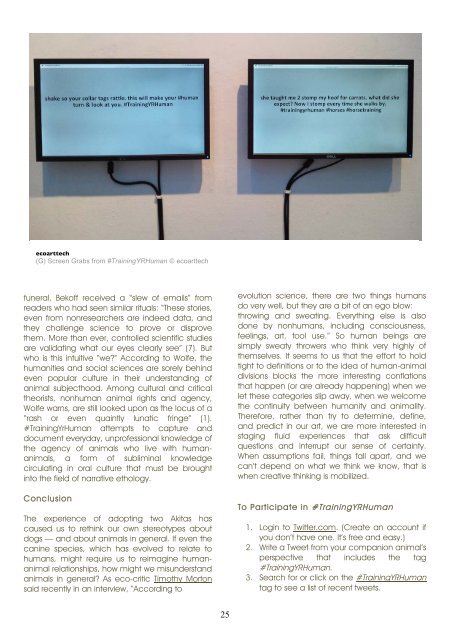Animal Influence I - Antennae The Journal of Nature in Visual Culture
Animal Influence I - Antennae The Journal of Nature in Visual Culture
Animal Influence I - Antennae The Journal of Nature in Visual Culture
You also want an ePaper? Increase the reach of your titles
YUMPU automatically turns print PDFs into web optimized ePapers that Google loves.
ecoarttech<br />
(G) Screen Grabs from #Tra<strong>in</strong><strong>in</strong>gYRHuman ecoarttech<br />
funeral, Bek<strong>of</strong>f received a “slew <strong>of</strong> emails” from<br />
readers who had seen similar rituals: “<strong>The</strong>se stories,<br />
even from nonresearchers are <strong>in</strong>deed data, and<br />
they challenge science to prove or disprove<br />
them. More than ever, controlled scientific studies<br />
are validat<strong>in</strong>g what our eyes clearly see” (7). But<br />
who is this <strong>in</strong>tuitive “we?” Accord<strong>in</strong>g to Wolfe, the<br />
humanities and social sciences are sorely beh<strong>in</strong>d<br />
even popular culture <strong>in</strong> their understand<strong>in</strong>g <strong>of</strong><br />
animal subjecthood. Among cultural and critical<br />
theorists, nonhuman animal rights and agency,<br />
Wolfe warns, are still looked upon as the locus <strong>of</strong> a<br />
“rash or even qua<strong>in</strong>tly lunatic fr<strong>in</strong>ge” (1).<br />
#Tra<strong>in</strong><strong>in</strong>gYrHuman attempts to capture and<br />
document everyday, unpr<strong>of</strong>essional knowledge <strong>of</strong><br />
the agency <strong>of</strong> animals who live with humananimals,<br />
a form <strong>of</strong> sublim<strong>in</strong>al knowledge<br />
circulat<strong>in</strong>g <strong>in</strong> oral culture that must be brought<br />
<strong>in</strong>to the field <strong>of</strong> narrative ethology.<br />
Conclusion<br />
<strong>The</strong> experience <strong>of</strong> adopt<strong>in</strong>g two Akitas has<br />
caused us to reth<strong>in</strong>k our own stereotypes about<br />
dogs — and about animals <strong>in</strong> general. If even the<br />
can<strong>in</strong>e species, which has evolved to relate to<br />
humans, might require us to reimag<strong>in</strong>e humananimal<br />
relationships, how might we misunderstand<br />
animals <strong>in</strong> general? As eco-critic Timothy Morton<br />
said recently <strong>in</strong> an <strong>in</strong>terview, “Accord<strong>in</strong>g to<br />
25<br />
evolution science, there are two th<strong>in</strong>gs humans<br />
do very well, but they are a bit <strong>of</strong> an ego blow:<br />
throw<strong>in</strong>g and sweat<strong>in</strong>g. Everyth<strong>in</strong>g else is also<br />
done by nonhumans, <strong>in</strong>clud<strong>in</strong>g consciousness,<br />
feel<strong>in</strong>gs, art, tool use.” So human be<strong>in</strong>gs are<br />
simply sweaty throwers who th<strong>in</strong>k very highly <strong>of</strong><br />
themselves. It seems to us that the effort to hold<br />
tight to def<strong>in</strong>itions or to the idea <strong>of</strong> human-animal<br />
divisions blocks the more <strong>in</strong>terest<strong>in</strong>g conflations<br />
that happen (or are already happen<strong>in</strong>g) when we<br />
let these categories slip away, when we welcome<br />
the cont<strong>in</strong>uity between humanity and animality.<br />
<strong>The</strong>refore, rather than try to determ<strong>in</strong>e, def<strong>in</strong>e,<br />
and predict <strong>in</strong> our art, we are more <strong>in</strong>terested <strong>in</strong><br />
stag<strong>in</strong>g fluid experiences that ask difficult<br />
questions and <strong>in</strong>terrupt our sense <strong>of</strong> certa<strong>in</strong>ty.<br />
When assumptions fail, th<strong>in</strong>gs fall apart, and we<br />
can’t depend on what we th<strong>in</strong>k we know, that is<br />
when creative th<strong>in</strong>k<strong>in</strong>g is mobilized.<br />
To Participate <strong>in</strong> #Tra<strong>in</strong><strong>in</strong>gYRHuman<br />
1. Log<strong>in</strong> to Twitter.com. (Create an account if<br />
you don’t have one. It’s free and easy.)<br />
2. Write a Tweet from your companion animal’s<br />
perspective that <strong>in</strong>cludes the tag<br />
#Tra<strong>in</strong><strong>in</strong>gYRHuman.<br />
3. Search for or click on the #Tra<strong>in</strong><strong>in</strong>gYRHuman<br />
tag to see a list <strong>of</strong> recent tweets.












